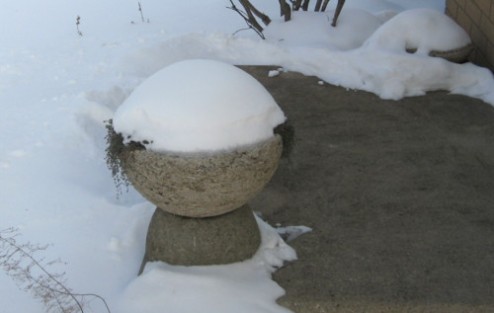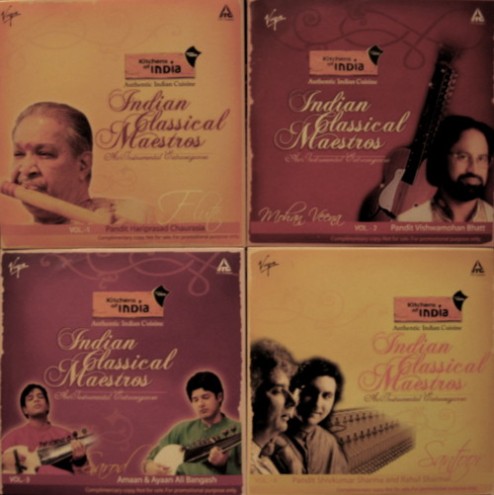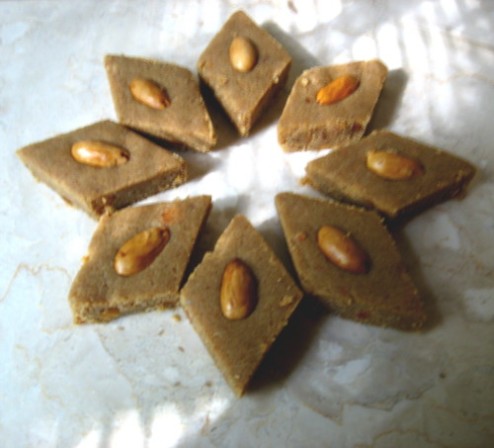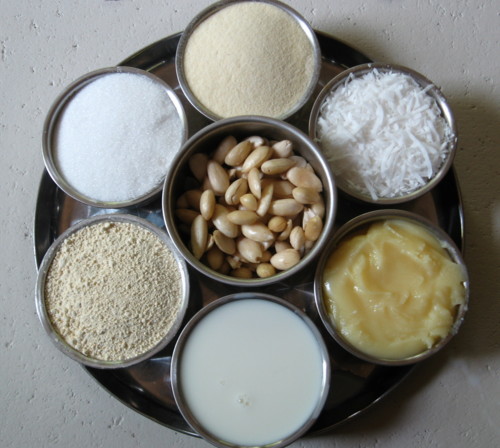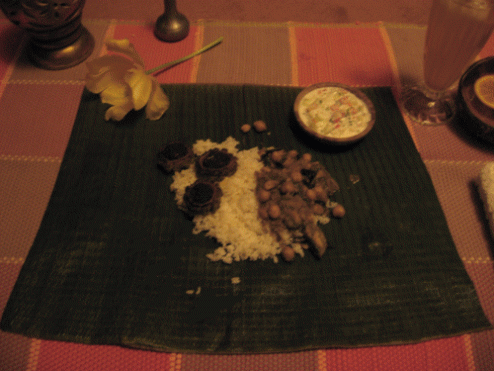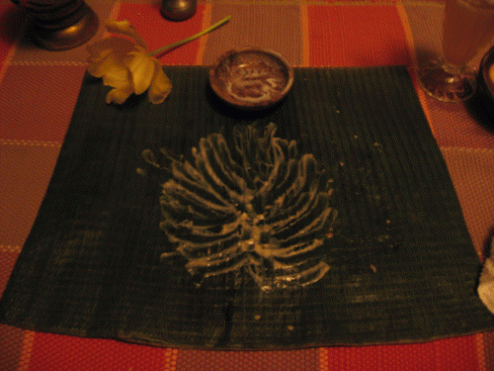Chickpeas and Panir with Tomatoes and Garlic
The last few days I’ve been “laid up” with a back injury- nothing too serious- just a few strained muscles, and I am doing pretty well right now. But, during that time, I needed something fairly quick and easy to make as a main protein source, so I thought of making an old Jaffrey standby: chickpeas and potatoes in tomato and garlic sauce. It has no long onion-bhuno-ing step; instead, a massive amount of garlic paste is fried in oil, tomatoes are added and slowly simmered…(well, at least it’s an easier bhuno-ing that didn’t require me to stand for too long!), and then a fairly brief cooking of the sauce with the chickpeas. Instead of potatoes, I thought of using panir as I had pre-fried a home-made batch of it a day or two before my injury and tucked it away in the fridge. The rest I did in parts as I could tolerate it- but I must confess to you that I ended up reclining on the floor to peel the garlic!
Since I was a little bit in want of fun, I decided not to follow the rest of that original recipe exactly; instead, I took a cue from one of my favorite bloggers- the famous Musical and her equally famous Kitchen. Musical is always playing around with new ingredient combinations and trusting her instincts to concoct interesting mixes of spices- all the while managing to create some really delicious dishes. So I thought “why not?” and took her cooking-is-as-easy-as-breathing approach, and, amazingly, my experiment turned out! It tasted so good that I decided to share it with y’all… and especially this is for other garlic-tomato-chile combo lovers out there! (You know who you are!)
Chickpeas and Panir with Tomatoes and Garlic
2 C dried white chickpeas/ kabuli chana
3 T oil/ghee
1 t cumin seeds
pinch of hing
18-24 cloves of garlic, pasted- about 3 T
2 C tomato puree
2 t coriander seeds (dry-roasted)
1 t cumin seeds (dry-roasted)
1 t ground red chiles, or to taste
1/2 t turmeric
1 1/2 t amchoor (or lime juice to taste)
2-3 C panir cubes, lightly fried in oil and drained
2 t kasoori methi, finger-crushed
6 green chiles (I used serranos), sliced into 1/8″ rounds (de-seed if you prefer it milder)
3 C broth from the cooked beans
salt to taste
1)Rinse chickpeas well, then cover in plenty of water to soak 12 hours; drain, then add fresh water to cover by an inch or two and cook for 5 minutes at 15 lbs. in a pressure-cooker, allowing pressure to fall on its own and cool- or simmer in enough water to cover until tender. Drain, reserving 3 C of broth.
2)Dry-roast coriander seeds and 1 t of cumin seeds until medium-brown; cool, and grind to a powder.
3)Heat oil or ghee over med-low, add the remaining teaspoon of cumin seeds, fry for a few seconds, then add the hing, followed by the garlic paste; fry, stirring continuously until the raw smell disappears (keep your face away actually!)- about 2-3 minutes, until garlic is a pale brown and has lost most of its moisture.
4)Add the tomato puree, stir well and slowly fry, stirring occasionally at first and more frequently as it reduces, until the oil returns and appears at the edges.
5)Add the dry-roasted spices, turmeric, ground chiles, and amchoor; fry for about 2 minutes more.
6)Add the cooked chickpeas, panir, kasoori methi, sliced chiles, and reserved broth; mix gently, bring slowly to a simmer and allow to cook uncovered for 30 minutes or so, stirring occasionally; add salt to taste. Serve with any flat-bread of choice- para(n)thas are always good. 😀 But I was feeling perky today so I made pooris; I was thrilled because they all puffed up like balloons and one of them was actually round! 🙂
(clockwise: chickpeas and panir…, bitter melon stir-fried…, a round poori, homemade karela ka achaar, Bihari-style saag/pureed green stuff)
Pindi Chole/Chana (Ek)
Yes, I know I ought to be blogging about pecan pie, mashed potatoes, Lithuanian mushrooms and beets, Hungarian lima beans, or…uh…..mole poblano…but, after all the leftover turkey (which was subsequently made into soup and turkey salad sandwiches) and, in short, the slew of western food which has totally thrown my system out of whack, I’m back to cooking food that I crave and enjoy on a daily basis…for a bit at least, so bear with me if you’re hanging on for one of those aforementioned recipes!
I had never heard of Pindi chana until a few months ago, when a locally-owned-and-extremely-large grocery store had a sale on packs of Kitchens of India convenience food for $1.50 each. No biggie really, except each one also contained a free CD of Indian classical music- a possibility of four different ones! Wowee!!! Well, I thought it would be fun to try and get all four, and in the process I tried every dish in their line. I wasn’t terribly impressed with any of them (kind of bland), but one of them wasn’t too bad after I “doctor’d it up” with some garam masala and extra ground chiles…anyway, I eventually managed to find all four CDs (you can sleep easy now my readers), and then I made a point of doing some research on this dish called Pindi chana…
Or Rawalpindi chana…Rawalpindi is a city in the Punjabi province of present-day Pakistan, with an extremely long history of several invasions and changes in power. The city contains many fine examples of architecture- ancient Buddshist, Hindu, and impressive Moghul shrines, two lively bazaars to wander about, as well as countless restaurants, food-stalls, and street-vendors from which to sample the local fare.
And I imagine that the variation in chana recipes is endless…which is what I discovered when I went Pindi-chana-recipe-hunting. Some said that kala (black) chana should be used, others said kabuli (white)…some said that it should be made with amla (Indian gooseberries) for souring and to achieve a dark colour, some said tea bags are the thing. Some used tomatoes, some stated that tomatoes shouldn’t be used at all. And then, there is a dispute over onions: only raw to accompany the final dish, and then no…browned as part of the masala, as well as raw for a final sparkle. Oh, it just goes on and on….the only thing I know for certain is that I won’t know anything until I visit this city, which I would really like to do someday. And when I get there, I’ll be sure to try every offering of chana I see and report to you here what I find out. But, I couldn’t possibly believe that just ONE recipe is being prepared all across a city of 3 million….can you?
I decided to try a recipe which Ashwini of Food for Thought stumbled upon in a most unlikely place: the booklet that accompanied her new pressure-cooker! I chose to try it first because it was the most different from all the others that I had read. After the first whirl, I found that it also tastes absolutely different from any other chana/chole recipes I have ever tried, and I like it very much, so much so that I’ve made it four times now! That’s blog-worthy I think.
Over the course of these recipe-runs, I found myself making a few changes in method- nothing that compromises the original intention of the recipe, no- namely a way to do both a brief oil-extraction of the masala while avoiding the overcooking of the chickpeas, and waiting until the end of the cooking to add the garam masala to avoid evaporating off all of the precious (and volatile) oils of elaichi…
Pindi (Rawalpindi) Chole (Chana)
2 C dried Kabuli chana (white chickpeas)
2 heaping teaspoons of black tea, coarsely powdered*
2 badi/moti/kala elaichi
5 cloves, ground**
3 small sticks of cinnamon (I use about 3-4 inches of cinnamon- like a finger-length)
3 T ghee and/or peanut oil (the original recipe uses 8 T…use any amount you prefer)
4 green chiles
1/2″ of fresh ginger
1 T whole cumin
1 1/2 T whole anardana
1 1/2 T coriander seeds, ground
1 T amchoor
1 1/2 t black pepper, ground
salt to taste
1-2 t garam masala
coriander leaves
sliced onions
1)Soak the chickpeas for 24 hours; drain, rinse once and drain again; place these, along with the tea, kala elaichi, cloves, cinnamon, and water to cover 1-2″ in a pressure-cooker; cook for 12 minutes at 15 PSI; remove from heat and allow to cool and pressure to fall (or cook in a large saucepan until tender). Drain, reserving liquid. Remove and discard kala elaichi and cinnamon.
2)Meanwhile: halve the chiles, de-seed, then quarter lengthwise; cut across into 1/8″ strips. Peel the ginger, then slice into thin rounds; stack the rounds and cut into fine shreds. Dry-roast, separately, the cumin and anardana seeds; grind and combine with the other dried spices, reserving the garam masala alone in another bowl.
3)Heat the oil to smoking, then add green chiles and ginger; stir once and add the ground spices; stir once again and add the reserved liquid from chana; keep at a slow boil, stirring frequently as it reduces and lowering heat as you go, until thick enough to coat the stirring-spoon.
4)Add the drained chickpeas and salt to taste; stir carefully over gentle heat until fully-hot. Remove from heat and stir in the garam masala.
5)Serve topped with sliced raw onions and coriander leaves. What is this served with? I don’t know…I usually eat it with rice. And I must say that the flavour is even better the day after it is made!
*The original recipe calls for 1 tea bag. I thought it should be darker still, plus I mostly buy loose tea so that I can pretend to read fortunes in a cup. The extra fiber doesn’t hurt either, and I do recall reading about a tea-leaf salad somewhere…
**The original recipe calls for 5 whole cloves to be cooked with the chana and then fished out afterwards. I got tired of trying to find them and decided to grind them up.
P.S. You may be wondering (or not) if I’ll be trying other Pindi chana recipes in the future and blogging about them? You bet! But the story will always go from free CDs to Ashwini’s complimentary booklet from a pressure-cooker, and then onwards…
8-cup Barfi (7-cup barfi- enlightened)
This is really a recipe for 7-cup barfi, a very popular Indian sweet with many different known formulas, all centering on the use of 7 cups of various ingredients. I like this one because every cup is a different thing, and I added another cup because I felt that the nuts, which are often included in the recipes, should be given their own cup; in short, I felt bad for them… 😦
Sort of… 🙂 the whole truth is that I was experimenting with my favorite 7-cup recipe and botched a batch that needed remedying: I had left out a cup of moong flour, not because I was out of stock- I wasn’t, but because I felt it a bit redundant to use two different bean-flours in one sweet. Plus, I wanted a nice, green-free colour…
So, to summarize: I had increased the nuts to one cup and omitted the moong flour. It didn’t work. Sue me. When the mixture was poured into a thali I had pools of unabsorbed ghee floating about. Ghee is far too precious of a substance to not be occupied somewhere… so, after staring into the pools for a while, looking at the room reflected in the depths, I thought of a possible solution: I roasted an eighth, non-legume ingredient (7th if the nuts aren’t counted- apparantly nuts don’t absorb ghee as well as starchy flours do!) and dumped the thali-contents back into the pan to re-heat and marry it to the new addition. Thankfully, it worked out splendidly, and I shall have no need now to keep searching for the best 7-cup barfi recipe out there, because the best one has 8 cups! 😉
Here is an interesting excerpt from Wikipedia’s entry for the number 8 and its significance to Buddhist thought:
The Dharmachakra, a Buddhist symbol, has eight spokes. The Buddha’s principal teaching — the Four Noble Truths — ramifies as the Eightfold Noble Path. In Mahayana Buddhism, the branches of the Eightfold Path are embodied by the Eight Great Bodhisattvas (Manjushri, Vajrapani, Avalokiteshvara, Maitreya, Kshitigarbha, Nivaranavishkambhi, Akashagarbha, and Samantabhadra). These are later (controversially) associated with the Eight Consciousnesses according to the Yogachara school of thought: consciousness in the five senses, thought-consciousness, self-consciousness and unconsciousness-‘consciousness’ (alaya-vijñana). The ‘irreversible’ state of enlightenment, at which point a Bodhisattva goes on ‘autopilot’, is the Eight Ground or bhūmi. In general, ‘eight’ seems to be an auspicious number for Buddhists, e.g., the ‘eight auspicious symbols’ (the jewel-encrusted parasol; the goldfish (always shown as a pair, e.g., the glyph of Pisces); the self-replenishing amphora; the white kamala lotus-flower; the white conch; the eternal (Celtic-style, infinitely looping) knot; the banner of imperial victory; the eight-spoked wheel that guides the ship of state, or that symbolizes the Buddha’s teaching). Similarly, Buddha’s birthday falls on the 8th day of the 4th month of the Chinese calendar.
Also, an octopus has eight arms, a fallen 8 is a symbol for infinity, and 8 this will be after it is made and gone! 😀
8-cup Barfi
- 1 C ghee (don’t you dare use anything else!)
- 1 C sugar (I used white, but any dry sugar of your choice will work)
- 1 C milk
- 1 C raw almonds, skinned (soak almonds in hot water for an hour to easily remove the skin)
- 1 C coconut, shredded (fresh, frozen or dried will work)
- 1 C semolina
- 1 C besan
- 1 C brown rice flour (will white rice flour work you might ask? Possibly… probably. I like the added nutrition and fiber of brown rice, in certain cases.)
- 1/2 t cardamom, whole seeds (elaichi)
- a few strands of saffron, crushed
- a pinch of salt
1)Blop two spoons of the ghee in a large cooking vessel (I used a wok) and set it over medium-low flame. Smear a bit of ghee on a thali and set aside.
2)Combine the sugar with the milk in a small sauce-pan and set it over low heat, stir occasionally until it just comes to a boil and the sugar dissolves. Remove from heat and sprinkled the crushed saffron threads and the salt over it and set aside.
3)Simultaneously, add the nuts to the hot ghee and fry, turning constantly, until fragrant and golden-brown. Remove to a bowl.
4)Fry/toast the coconut in the same pan, using the ghee that remains in the pan which was used for the almonds, turning constantly, until it is golden and fragrant (use caution when roasting coconut; it will go from tan to black quite quickly!). Remove to a separate bowl.
5)Roast the three flours separately in turn, using the same pan, until each is golden and fragrant. Remove these to rest in a bowl together (be sure to remove as much as you can from the pan before roasting the next).
6)Crush the cardamom seeds in a mortar, add the toasted coconut and crush this to a coarse paste.
7)Pick out a handful of the most beautiful, evenly-coloured roasted almond halves from the bowl and reserve these for decorating. Add the remainder to the coconut in the mortar and crush to a coarse paste.
8)Add the remaining ghee from the cup to the pan (as well as any ghee that clings to the bowls you used for the almonds and coconut)and set it over med-low heat; add the roasted flours and mix well. Add the milk-water mixture and continue heating and stirring until the mixture leaves the sides of the pan and moves as one mass. Add the paste from the mortar and mix well.
9)Turn out onto the thali and pat it down well until quite smooth using a metal spatula. Score the surface into diamond shapes using a dull knife. Press an almond-half into the center of each diamond and allow to cool. (place any nuts that remain after decorating in a small bowl and hide it in a cabinet to secretly munch later)
10)When cool, use a sharp knife to cut all the way through the score-marks. Serve with tea, coffee or cooling drinks.
Amazingly, this melt-in-the-mouth sweet seems to be impervious to humidity… so try it now; don’t procrastin-8!
Soyi bahjill chane gashi (chick-peas in roasted coconut gravy) + Stuffed Bitter-gourds I (Konkani? Tamil?)
I’ll admit this to all of you: my absolute favorite legume/pulse is channa, AKA gram, chole, garbanzo bean, chick-pea……kabuli or badi/kala…..and also known as many, many other names around the world, but I know it as delicious!
Over the years, I have tried several recipes of Indian origin, most of them Punjabi. I can’t blame them for their fondness, no….not at all! And while I find great pleasure in devouring these near-spherical wonders in rich browned onion and tomato or tamarind sauces, I found myself yearning for something new, something that I hadn’t yet found, and yet steeped in a long tradition that had as yet not revealed itself to me. That is, until a few days ago, when I happened upon a very intriguing recipe hidden in the folds of Manjula’s marvelous collection of Konkani recipes, Daalitoy.
I think what intrigued me most while reading over her recipe, besides the lush coconut, red chile, and tamarind- based gravy, was the very subtle use of lightly-roasted methi seeds to add an almost imperceptible note within the layers of flavour. Manjula described two ways of making this dish: the first was with fresh, unroasted coconut and the use of methi made optional. As I tend to welcome a bit of luxury and greater complexity in flavour, I opted to prepare what she described as “a special variation of chane gashi” made with roasted coconut called soyi bahjill chane gashi.
Let me tell you now, I was not disappointed! This dish, because of the complex aromatics released while roasting not only the coconut, but the chiles and methi as well, and also added to this the final tadke with its bounty of curry leaves, will literally bask your olfactory senses in sheer delight! Such a few, simple ingredients made into perfection! And look, I haven’t even mentioned the chick-peas since I began. It’s that good.
This dish is traditionally prepared with the addition of a mild-flavoured, starchy vegetable that soaks up the delicious gravy like a sponge. She strongly recommends green jackfruit (fresh or tinned) if you have access; I opted for one of the other three that she mentioned: green banana (such as unripe plantain). After tasting this, I think I could recommend a few more, if I may be so bold: sweet potatoes, taro root, sweet cassava, jicama….
Soyi Bajill Chane Gashi
1 C chane, preferably kala/badi, but kabuli is fine too
1 C coconut, freshly grated or frozen
10-16 dried red chiles
a piece of tamarind, the size of a small lime
8-10 fenugreek/ methi seeds
1 C diced green jackfruit(fresh or canned)/suran(Indian yam)/green banana/potatoes
salt to taste
2 t oil
1/2 t mustard seeds
a pinch of hing(my addition…for greater authenticity, Manjula stated that this is not usually included.)
4 sprigs of curry leaves
1)Rinse chane and soak in water for 24 hours. Drain and cook in pressure cooker(20 min at 15#) or boil in water until just tender. Drain, reserving liquid.
2)Wipe the inside of a pan with oil and roast coconut, stirring constantly over med-low heat, until golden and fragrant. Remove to grind.
3)Seed chiles(if desired) and break into pieces. Roast in the same pan until they turn a shade darker. Remove and add to coconut.
4)Soak the tamarind in hot water for 30 min; pour through sieve and press as much liquid through as you can. Discard pulp and seeds, but collect any extract clinging to the bottom of the sieve.
5)In a grinding mechanism(I used a food processor) grind the coconut and chiles, adding a bit of reserved chane broth when necessary to achieve a smooth paste. Add tamarind to balance the sweetness (This paste is called masolu).
6)Lightly roast the methi seeds until a shade darker and fragrant. (Do not let them burn as they become too bitter). Grind to a powder (I used a mortar-and-pestle and then added chane broth to the mortar to make a “methi water”).
7)Take the paste, methi, diced vegetable, and cooked chane in a pot, add enough reserved chane broth to thin to a gravy. Bring to a boil, and simmer, stirring frequently, to cook vegetable and blend flavours (5 min if using canned jackfruit or 30 min or so otherwise). Add more broth as needed, and salt to taste.
8)Heat oil in a small pan, add mustard seeds. When they pop, add hing(optional) and curry leaves and fry for a bit. Pour this over the finished dish.
I teamed this up simply with plain rice and, instead of Manjula’s suggestion of podi (vegetable fritters), I decided on stuffed bitter melon (origin of recipe as yet unknown), and mosaru bajji, an excellent recipe I found within Shilpa’s collection. Thanks to you both (and hopefully neither of you are giggling over this combination for a meal!) 🙂
BONUS RECIPE!!!!!!!!!!! If anyone can identify positively the place of origin of the following dish, I will post absolutely any requested dish in the world within one moon cycle. (disclaimer: if I absolutely cannot obtain a certain ingredient, reasonable substitutions must be allowed)
Stuffed Bitter-gourds (from Premila Lal’s Indian Recipes, Premila Lal, 1968)
-written exactly as it is in the book
2 large bitter-gourds
2 T ghee
To be fried then powdered:
3 t black gram dhal
5 t coriander seeds
1/2 t cumin seeds
1/2 t fenugreek seeds
Grind to a fine paste:
8 dry red chillies
1 small ball of tamarind(size of a small lemon)
A little asafoetida (size of a tamarind seed)
Salt to taste
Wash the bitter-gourds and cut into even round pieces. Remove only the seeds from the pulp then stuff these pieces with the thick paste made by mixing the fine paste with the powdered ingredients. Cook on steam ’til tender.
Place a saucepan on a low heat and heat 1 tablespoon ghee. Transfer the cooked bitter-gourd pieces to the saucepan and pour the remaining ghee over them. Fry them on both sides ’til they become crisp and brown in colour.
Serve with idlis, rice or chappatis, as preferred.
Bee of Jugalbandi has added in her comment: “Tamilians have this penchant for urid dal. J. says it looks very Tamilian (he’s one). Keralites would use rice flour to crispen it, so it isn’t from Kerala.
Anju from Mangalore has added from a comment: “The stuffed bitter gourd recipe is very similar to a Konkani dish my mom used to make (and I try to copy ineffectively) and is called ‘Karathe Pathrado’ (or ‘Karathe Kudko’ in some circles). The only difference is the method of cooking the Karathe (Bitter gourd) after stuffing it. My mom’s method calls for heating some oil, spluttering mustard seeds in it and placing the stuffed pieces in the hot oil. After crisping up the bottom side of Karathe, water is added around the pieces (1/2cup maybe) and the lid closed and the pieces steamed until almost done. Then, the pieces are turned over and cooked on the second side until that side has crisped up and the pieces are fully cooked.”
NOTE—–> This book, although printed under a single authoress, appears to be a compilation of recipes from many writers, as there is little uniformity in ingredient names or wording. (It reminds me of the American “church cookbooks” that are made by collecting donated recipes to raise charity money). A fine collection of recipes none-the-less….definitely a personal treasure…
